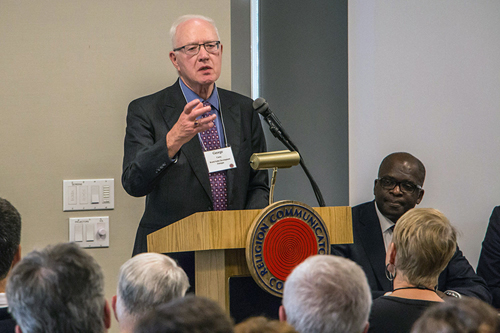
Lord George Carey speaks at the Religion Communicators Council in March 2016. PICTURE: Courtesy of George Carey
In a dramatic coda to a dark chapter in the Church of England, former Archbishop of Canterbury Lord George Carey stepped down from an honorary role after a report on child sex abuse accused the church under his leadership of collusion.
Lord Carey resigned after current Archbishop of Canterbury Justin Welby made the unprecedented decision to ask him to step aside from his post as honorary assistant bishop in the Diocese of Oxford, a position often given to retired senior clergy.
The resignation highlights how church institutions are shifting their focus to punishing church officials for their roles in covering up child sex abuse by priests, even as some criticise them for not sufficiently addressing the needs of the victims.
Lord Carey was castigated in an independent review, published last week, into the way the church handled abuse by another bishop, Peter Ball. The study by Dame Moira Gibb said that as Archbishop of Canterbury, Lord Carey failed to pass on information about Ball to the police. Further allegations against Ball led to his imprisonment in 2015. Gibb’s appraisal said the church “colluded (with the abuser) rather than seeking to help those he had harmed.”
The review also found that after Ball was convicted of gross indecency, Lord Carey received several letters from families and individuals about the bishop’s behavior but failed to hand over six of the letters to police. Lord Carey also neglected to put Ball on the so-called Lambeth List, which listed clergy about whom there was doubt over their suitability for ministry.
Ball served in prison for two years and six months after pleading guilty to offenses against 18 teenagers and young men between the 1970s and 1990s.
The report, called Abuse of Faith, commissioned by Archbishop Welby after Ball’s conviction in 2015, highlights not only the way in which Ball abused boys for more than 20 years but also the extent to which the church did nothing to help his victims. Dame Moira described “the failure of the church to respond appropriately to his misconduct, again over a period of many years”.
The report also records how Lord Carey did not stop Ball even after he had resigned as bishop of Gloucester following the gross indecency charge. The bishop continued to serve in ministry at 17 private schools.
“I believed Peter Ball’s protestations and gave too little credence to the vulnerable young boys behind those allegations,” Lord Carey said.
Phil Johnson of MACSAS, an organisation for survivors of clergy abuse, said: “The church and the establishment colluded in covering up Bishop Peter Ball’s offending at the highest level over very many years.”
The way in which the Church of England dealt with the abuse will come as no surprise to those who monitor sex abuse cases and the way in which institutions have dealt with them – usually by focusing on the reputation of the institution and the welfare of the cleric-perpetrator.
In her report, Dame Moira highlighted this problem: “Ball was seen by the Church as the man in trouble whom the Church needed to help…the Church appears to have been more interested in protecting itself.”
Rev Klaus Mertes, a German Jesuit who spoke at Oxford University late last year about the way the Catholic Church has dealt with child sexual abuse cases, has analysed how church institutions have focused on their needs rather than the victims’.
Rev Mertes identified another common theme in church institutions – the way they often see themselves as victims too – and he warned: “For the process between institution and victim it is important, first of all, that the representatives of the institution assume responsibility for their own failure − so that they certainly do not define themselves as victims, but admit to their systemic membership of the offenders’ side.”
Ball is not the only priest-abuser in the Church of England but one of its most senior members.
Dame Moira’s report did not look at the root causes of his predatory pursuit of young boys but its consequences.
But the underlying causes of abuse are a key issue for churches, too.
Unlike most Anglican priests, Ball was a member of a monastic order and therefore required to live a celibate life.
Hans Kung, a Catholic theologian and advocate of reform, has said celibacy is a cause of child sexual abuse in the Catholic Church.
Leading sexologist Klaus M Beier rejects that assertion, saying celibacy is not the cause of pedophilia or hebephilia, the desire for adolescents.
But Professor Beier, who heads the Institute of Sexology in Berlin and has studied paedophile behavior, does think it plays a part. He argues that paedophiles recognise that their behavior is unacceptable and seek external ways to limit it.
“Celibacy is so attractive to paedophiles because they want to leave their conflict-laden sexuality behind them and liberate themselves from their sexual impulses,” he said.
Professor Beier added this is “a fatal fallacy” because taking refuge in an imposed rule eventually fails.
In England and Wales, both the Anglican and Catholic churches have set up systems to protect children from abusive priests and have acknowledged the hurt and damage done to victims.
But the causes of abuse are not the focus of the safeguarding teams, even though better understanding might help avoid more abuse in the future.
The Independent Inquiry into Child Sexual Abuse in England and Wales, convened by the British government, is examining abuse in the Church of England and the Catholic Church as part of a study that may take many years to complete.





